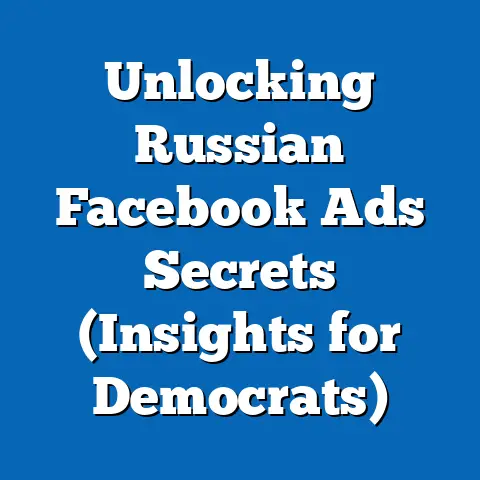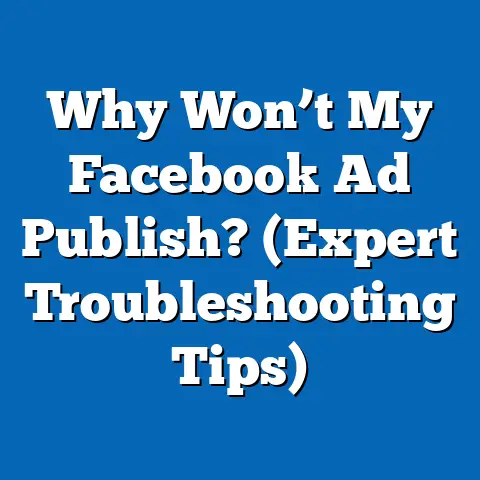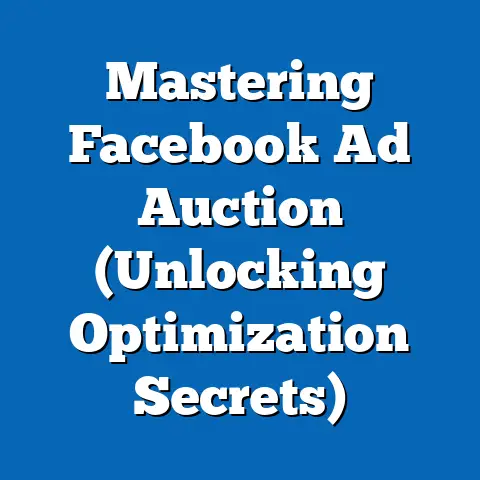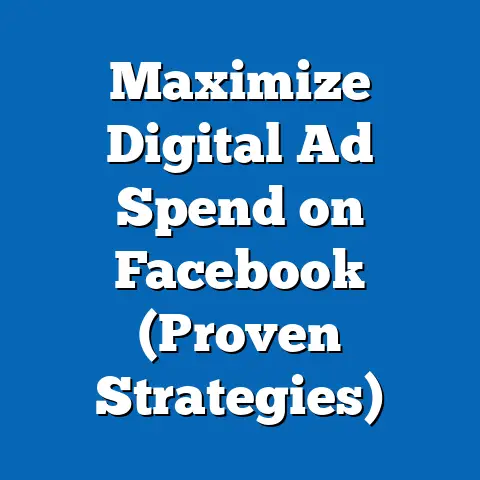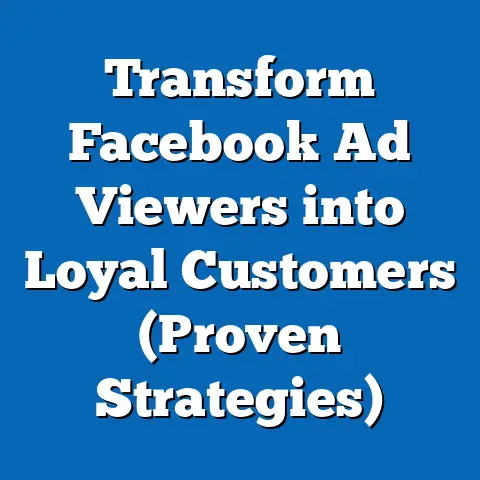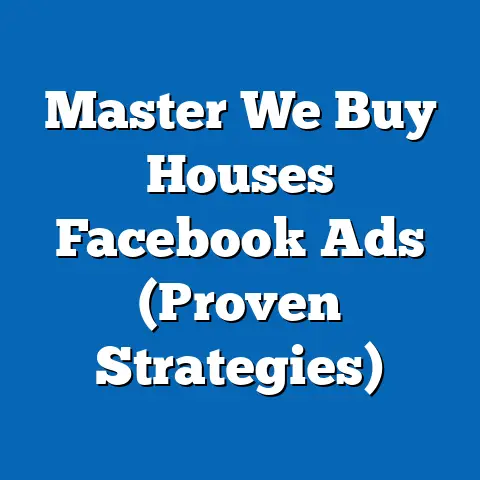Stop Ad Blockers on Facebook App (Insider Strategies)
Have you ever stumbled upon a product on Facebook that felt like it was made just for you? Maybe it was a quirky kitchen gadget that solved a daily frustration, a travel experience that opened your eyes to a new culture, or a local service that made your life significantly easier. These little discoveries, often fueled by targeted advertising, are what make the digital world so vibrant and connected.
I remember when I first saw an ad for a subscription box service tailored to my love for obscure stationery. It wasn’t just another ad; it was a portal to a world of unique pens, inks, and notebooks that I never knew existed. This experience made me realize that advertising, when done right, isn’t just about selling; it’s about enhancing our lives by connecting us with things we genuinely value.
Digital advertising has come a long way. From simple banner ads to sophisticated, personalized campaigns, it’s now an integral part of our daily lives. It shapes our consumer habits, introduces us to new trends, and even influences our social interactions. But what happens when this carefully crafted ecosystem is disrupted by ad blockers? How do businesses, especially small ones, continue to reach their audience and offer these lifestyle-enhancing discoveries?
In this article, I’ll dive into the world of ad blockers on Facebook, their impact on businesses, and the insider strategies you can use to mitigate their effects. We’ll explore how to create engaging content, leverage native advertising, personalize your targeting, and build a community around your brand to ensure your message reaches the right audience, even with ad blockers in place. Let’s unlock the full potential of Facebook advertising, one strategy at a time.
Understanding Ad Blockers and Their Impact
What are Ad Blockers?
Ad blockers are software tools designed to prevent advertisements from appearing on websites and within apps. They work by identifying and blocking the code, scripts, and servers that deliver ads. While ad blockers are often praised for improving browsing speed, reducing data consumption, and enhancing privacy, they can significantly impact businesses that rely on advertising revenue.
In the context of the Facebook app, ad blockers can be particularly challenging. Unlike web browsers where ad blockers are typically extensions, ad blocking in mobile apps often requires more sophisticated techniques, like VPN-based solutions or modified app versions. These methods filter traffic to prevent ads from loading, thereby disrupting the intended user experience from an advertiser’s perspective.
Ad Blocker Usage Among Facebook Users: Statistics and Trends
The use of ad blockers has been steadily increasing over the years. According to Statista, approximately 27% of internet users worldwide use ad blockers as of 2023. While specific data on Facebook app ad blocker usage is less readily available, the trend suggests a significant portion of Facebook’s massive user base is actively blocking ads.
Demographically, ad blocker usage tends to be higher among younger, more tech-savvy users who are concerned about privacy and data usage. However, the appeal of a cleaner, faster browsing experience is spreading to older demographics as well. This means businesses need to be aware that a substantial segment of their potential audience may not be seeing their ads at all.
The Negative Impact on Businesses, Especially Small Businesses
For businesses, especially small businesses, Facebook advertising is often a lifeline. It provides a cost-effective way to reach a large, targeted audience, drive traffic to their websites, and generate leads and sales. When ad blockers prevent these ads from being seen, it can have a significant negative impact on their bottom line.
I’ve seen firsthand how small businesses struggle when their Facebook ads are rendered invisible. One local bakery I worked with relied heavily on Facebook ads to promote their daily specials and seasonal treats. When a significant portion of their target audience started using ad blockers, their ad engagement plummeted, leading to a noticeable drop in sales. This highlights the critical need for businesses to adapt and find ways to overcome the challenges posed by ad blockers.
Key Takeaway: Ad blockers are a growing concern for businesses advertising on Facebook. Understanding their function, prevalence, and impact is the first step in developing strategies to mitigate their effects.
The Importance of Ads in Enhancing User Experience
Discovering New Products and Services Through Ads
While many view ads as an intrusive interruption, they can also be a valuable source of information and discovery. Think about it: How many times have you learned about a new product, service, or experience through an ad that genuinely improved your life? For me, it’s happened countless times.
For instance, I discovered a local pottery studio through a Facebook ad that offered beginner classes. It turned out to be an incredible hobby that not only helped me de-stress but also connected me with a community of like-minded individuals. This experience underscores how ads can serve as a bridge to new passions and enrich our lives in unexpected ways.
Successful Ad Campaigns and Lifestyle Upgrades
There are countless examples of successful ad campaigns on Facebook that have led to significant lifestyle upgrades for users. Consider the rise of meal kit delivery services. Companies like Blue Apron and HelloFresh initially gained traction through targeted Facebook ads that showcased the convenience and health benefits of their offerings. These ads resonated with busy professionals and families looking for ways to simplify meal planning and enjoy nutritious meals at home.
Another example is the surge in popularity of language learning apps like Duolingo. Their clever and engaging Facebook ads, often featuring humorous scenarios and gamified learning experiences, have inspired millions to start learning a new language. This not only enhances their personal development but also opens up new cultural and professional opportunities.
The Psychology of Advertising and Positive Consumer Behavior
Advertising, when done right, can drive positive consumer behavior by tapping into our needs, desires, and aspirations. It’s not just about showing us products; it’s about telling a story, creating an emotional connection, and offering a solution to a problem. When ads are relevant, personalized, and engaging, they can influence our behavior in positive ways.
For example, ads promoting sustainable and eco-friendly products can encourage consumers to make more environmentally conscious choices. Similarly, ads for fitness programs and healthy food options can inspire people to adopt healthier lifestyles. The key is to create ads that resonate with the audience on a personal level and offer genuine value.
Key Takeaway: Ads have the potential to enhance user experience by introducing new products, services, and experiences that improve the quality of life. By understanding the psychology of advertising and creating relevant, engaging campaigns, businesses can drive positive consumer behavior and build lasting relationships with their audience.
Insider Strategies to Combat Ad Blockers in the Facebook App
1. Create Engaging Content
The cornerstone of any successful advertising strategy is creating content that resonates with your audience. In a world saturated with ads, it’s crucial to stand out by crafting compelling narratives, using high-quality visuals, and offering genuine value.
Tips for Creating Engaging Content:
- Tell a Story: People are naturally drawn to stories. Use storytelling techniques to connect with your audience on an emotional level. Share personal anecdotes, customer testimonials, or behind-the-scenes glimpses of your business.
- Use High-Quality Visuals: Visuals are the first thing people notice in an ad. Invest in professional photography, videography, or graphic design to create eye-catching and visually appealing ads.
- Offer Value: Provide useful information, tips, or resources that your audience will find valuable. This could be a free guide, a discount code, or an exclusive offer.
- Keep it Concise: People have short attention spans. Get to the point quickly and use clear, concise language.
2. Leverage Native Advertising
Native advertising is a type of advertising that blends seamlessly with the user-generated content on a platform. On Facebook, this means creating ads that look and feel like organic posts. Because they don’t appear as traditional ads, native ads are less likely to be blocked by ad blockers.
Tips for Leveraging Native Advertising:
- Match the Platform’s Style: Make sure your ads match the look and feel of Facebook’s organic content. Use similar fonts, colors, and imagery.
- Focus on Value: Provide valuable content that your audience will find interesting and engaging. This could be a blog post, a video, or an infographic.
- Avoid Overt Sales Pitches: Don’t be too pushy with your sales message. Focus on building relationships with your audience and providing value first.
- Use Storytelling: Tell a story that resonates with your audience and connects with them on an emotional level.
3. Targeting and Personalization
Facebook’s robust targeting tools allow you to deliver personalized ads to specific segments of your audience based on their interests, demographics, behaviors, and more. By targeting your ads to the right people, you can increase their relevance and effectiveness, making them less likely to be blocked.
Tips for Targeting and Personalization:
- Define Your Target Audience: Who are you trying to reach? What are their interests, demographics, and behaviors?
- Use Facebook’s Targeting Options: Take advantage of Facebook’s detailed targeting options to reach the right people with your ads.
- Create Custom Audiences: Create custom audiences based on your website traffic, email list, or other data sources.
- Personalize Your Ads: Tailor your ads to the specific interests and needs of your target audience.
4. Utilize Video Ads
Video ads are highly effective at capturing attention and reducing the likelihood of being blocked. They are more engaging than static images and can convey a lot of information in a short amount of time.
Tips for Utilizing Video Ads:
- Keep it Short: People have short attention spans. Keep your video ads short and to the point.
- Use Eye-Catching Visuals: Use high-quality visuals that grab attention and keep viewers engaged.
- Tell a Story: Tell a story that resonates with your audience and connects with them on an emotional level.
- Include a Call to Action: Tell viewers what you want them to do after watching your video.
5. Incorporate User Feedback
Engaging with your audience and incorporating their feedback is essential for improving the relevance and effectiveness of your ads. By listening to what your audience has to say, you can create ads that better meet their needs and preferences.
Tips for Incorporating User Feedback:
- Ask for Feedback: Ask your audience for feedback on your ads. You can do this through polls, surveys, or comment sections.
- Monitor Comments and Reviews: Pay attention to the comments and reviews people leave on your ads. This can provide valuable insights into what they like and dislike.
- Respond to Feedback: Respond to feedback promptly and professionally. Show your audience that you value their input.
- Implement Changes: Use the feedback you receive to make changes to your ads and improve their relevance and effectiveness.
6. Promote Value-Added Content
Offering valuable content that users want to engage with, such as free guides or exclusive offers, can lead to higher conversion rates and reduce the likelihood of your ads being blocked. When you provide something of value, people are more likely to pay attention and less likely to see your ads as intrusive.
Tips for Promoting Value-Added Content:
- Identify Your Audience’s Needs: What problems are your target audience facing? What information or resources would they find valuable?
- Create High-Quality Content: Create content that is well-written, informative, and engaging.
- Offer Exclusive Deals: Provide exclusive discounts or offers to people who engage with your content.
- Promote Your Content Widely: Share your content on your website, social media channels, and email list.
Key Takeaway: By implementing these strategies, businesses can mitigate the impact of ad blockers and ensure their message reaches the right audience, even on Facebook.
Building a Community Around Your Brand
The Significance of Building an Authentic Community
Building an authentic community on Facebook is crucial for fostering loyalty and trust among users. When people feel connected to your brand and believe in your values, they are more likely to engage with your content, purchase your products, and recommend your business to others.
I’ve seen this firsthand with several local businesses. One particular coffee shop started hosting regular live music nights and trivia contests on their Facebook page. This not only drew in new customers but also created a loyal following that eagerly anticipated each event. Their Facebook page became a hub for the local community, and their business thrived as a result.
Strategies for Engaging with Users Beyond Ads
Engaging with users beyond ads is essential for building a strong community. This means creating content that is not directly promotional and focusing on building relationships with your audience.
Strategies for Engaging with Users Beyond Ads:
- Host Live Q&A Sessions: Host live Q&A sessions with your team or industry experts to answer questions from your audience.
- Create Polls and Surveys: Create polls and surveys to gather feedback and learn more about your audience’s preferences.
- Share User-Generated Content: Share content created by your users, such as photos, videos, or reviews.
- Run Contests and Giveaways: Run contests and giveaways to incentivize engagement and reward your audience.
- Participate in Relevant Groups: Join relevant Facebook groups and participate in conversations.
Transparency and Authenticity in Advertising
Transparency and authenticity are key to building trust with your audience. Be honest about your products and services, and don’t make false or misleading claims. When people trust your brand, they are more likely to engage with your ads and less likely to use ad blockers.
Tips for Transparency and Authenticity in Advertising:
- Be Honest: Be honest about your products and services. Don’t make false or misleading claims.
- Be Transparent: Be transparent about your business practices. Let people know how you operate and what your values are.
- Be Authentic: Be yourself. Don’t try to be something you’re not.
- Engage with Your Audience: Engage with your audience in a genuine and respectful way.
Key Takeaway: Building a strong community on Facebook requires more than just running ads. It requires creating valuable content, engaging with your audience, and being transparent and authentic in your advertising.
The Future of Advertising on Facebook
Ad Blockers, Technological Advancements, and Evolving Consumer Behaviors
The future of advertising on Facebook is likely to be shaped by several factors, including the continued use of ad blockers, technological advancements, and evolving consumer behaviors. As ad blockers become more sophisticated, businesses will need to find new and innovative ways to reach their audience.
Technological advancements, such as artificial intelligence and machine learning, are likely to play a significant role in the future of advertising. These technologies can be used to create more personalized and relevant ads, which are less likely to be blocked.
Consumer behaviors are also evolving. People are becoming more aware of the impact of advertising on their lives and are demanding more transparency and control over their data. Businesses will need to adapt to these changing behaviors by being more transparent and respectful of user privacy.
Potential Changes in Facebook’s Advertising Policies
Facebook is constantly evolving its advertising policies to improve the user experience and protect user privacy. In the future, we may see changes to Facebook’s targeting options, ad formats, and data collection practices.
Businesses need to stay informed about these changes and adapt their advertising strategies accordingly. This may involve using new targeting options, creating different types of ads, or changing the way they collect and use data.
Emerging Trends in Digital Marketing
Several emerging trends in digital marketing are likely to influence how ads are perceived and consumed in the future. These include:
- Personalization: Ads are becoming more personalized and relevant to individual users.
- Video Marketing: Video ads are becoming more popular and effective.
- Influencer Marketing: Influencer marketing is becoming a more mainstream advertising strategy.
- Augmented Reality (AR): AR is being used to create more immersive and engaging advertising experiences.
- Artificial Intelligence (AI): AI is being used to automate and optimize advertising campaigns.
Key Takeaway: The future of advertising on Facebook is likely to be shaped by ad blockers, technological advancements, evolving consumer behaviors, and emerging trends in digital marketing. Businesses need to stay informed about these changes and adapt their advertising strategies accordingly.
Conclusion: Embracing Opportunities in Advertising
While ad blockers present challenges, they also encourage innovation and creativity in advertising strategies. Instead of viewing ad blockers as a roadblock, businesses should see them as an opportunity to rethink their approach to engagement and connection with their audience.
I believe that the key to success in the future of advertising lies in creating valuable content, building authentic relationships, and being transparent and respectful of user privacy. By focusing on these principles, businesses can overcome the challenges posed by ad blockers and create advertising campaigns that are both effective and enjoyable for users.
So, embrace the change, adapt your strategies, and continue to seek ways to enhance the user experience through effective advertising. The future of advertising is bright, and with the right approach, you can unlock the full potential of Facebook and connect with your audience in meaningful ways.

